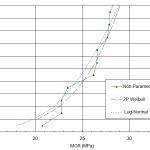Methods used to analyse structural timber test data
Once a representative sample of the general structural product quality has been gathered (refer to the earlier posted article on Sampling), and then tested (refer to earlier posted article on Compliance Test Methods), the next step to consider is which method of deriving the structural properties should be used.
The use of statistics is required to ascertain the lower 5th percentile values for the tested sample, from which the strength properties are based. There are 3 main statistical analysis options;
Each analysis option will give slightly different estimations of the lower 5th percentile value, so it is important to fit the assumed distribution to the data and visually check its fit to the test data. 
 These 3 methods estimating the lower 5th percentile were used on the same strength test data, which has been ranked in ascending order and plotted above.
These 3 methods estimating the lower 5th percentile were used on the same strength test data, which has been ranked in ascending order and plotted above.
Non-parametric (Data)
This method is highly dependent on the size of the sample and how representative it is of the overall production quality. The lower 5th percentile value is read off a plot of the ranked strength test values against the cumulative frequency, f = (i-0.5)/N; where i is ranked value (lowest = 1) and N is the sample size. The cumulative frequency plot of the ranked strength values is seldom a smooth curve, and the sample may under or over estimate the value of the lower 5th percentile strength value of the general timber resource.
Log-Normal
This is an assumed distribution using the mean and co-efficient of variation of all the strength test data to estimate the lower 5th percentile strength value. This distribution is generally favoured because of its good fit across the entire strength data set, and tends to give a slightly conservative estimate of the lower 5th percentile strength value, refer to the charts above.
2P Weibull
This is another assumed distribution and uses the co-efficient of variation of the lower tail of the strength test data to very accurately estimate the lower 5th percentile strength value with a small sample size. This method of estimating the lower 5th percentile value is best used when there is a high degree of confidence that the sample well represents the timber quality. reflects the general on material with lower variability.
